In Udon Thani and Nong Khai—two of the bigger cities in North Isaan—locals wear their identities proudly and welcome tourists to share their culture.
If you are looking to immerse yourself in Thailand’s culture and have personal encounters with local communities during your trip, you should visit the northern Isaan region.
In Udon Thani and Nong Khai—two of the bigger cities in North Isaan—locals wear their identities proudly and welcome tourists to share their culture. These encounters might happen in a quaint village, a riverside market, or a dreamlike statue park.
If you prefer the slow and peaceful lifestyle of the countryside, then you’ll feel right at home when you visit North Isaan. The smiles feel authentic, food tastes fresh, and colors look bright to the eye. You’ll feel like an honored guest as you make your way through Northern Isaan’s key locations.
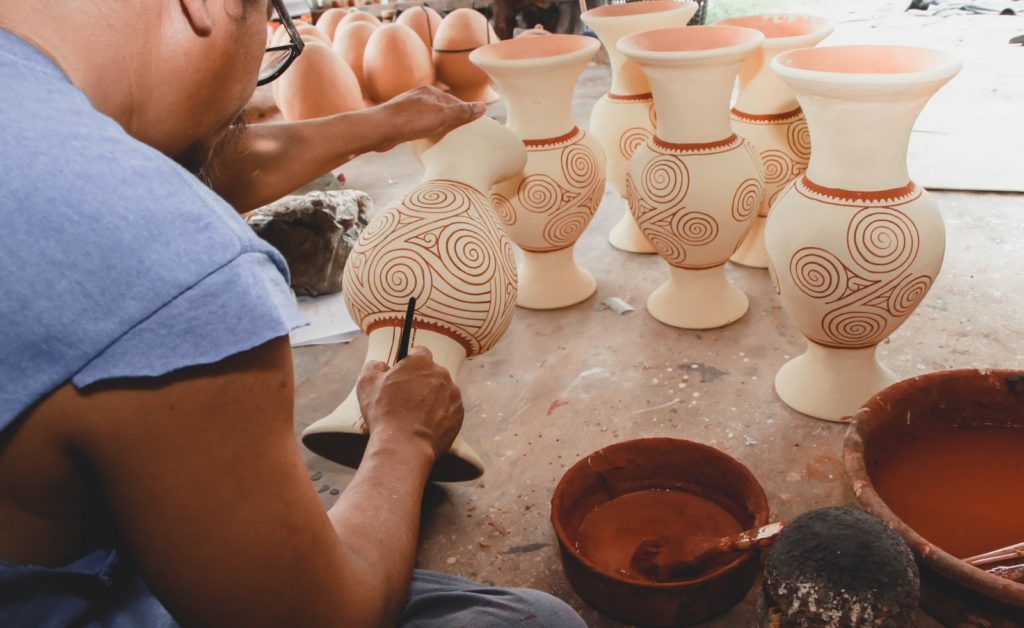
A Proud Ethnic Community in Udon Thani
The Isaan people are not only Thai but are also an ethnic community that shares their dialect and language, cultural, and historical roots with the people of Laos, which is located across the Mekong River. You can experience the flavor-filled food, distinct textiles, and crafts all at once during a visit to Ban Chiang Village in Udon Thani.
This area is unique to both tourists and locals. The UNESCO World Heritage Site recognized Ban Chiang Village as a World Heritage Site for its archaeological treasures: a cache of 5,000-year-old pottery with unique swirl markings.
The present-day Thai Puan community consider themselves guardians of Ban Chiang’s heritage. They have an immersive cultural experience that allows visitors to make their own Ban Chiang pottery, natural indigo dyed cloth, and participate in ceremonies like the Bai Sri Su Kwan that calls good spirits back home.
Visitors should also visit the Ban Chiang National Museum, whose English-language displays explain the significance of the pottery and its revelations about prehistoric culture in this part of the world.
Wat Pho Sinai is the only excavation site that is open to visitors in Ban Chiang, as the other sites have been filled in to protect priceless treasures.
If you’re looking for a quiet place to have peace of mind, visit Wat Hin May Pen. The temple was originally built as a Dharma practice place of Luangpu Thet, who made it a Dharma practice place for the monks, nuns, and pilgrims. The temple is spacious, clean and shady with various species of plants which are suitable for Dharma practice. It is adjacent to the Mekong River. The inside of the pagoda is a museum containing Luang Pu Thate Image, the eight necessities for a monk’s daily life, the necessities for pilgrimage who travel to various places, and Luangpu Thate Crematory, which was the place for his cremation ceremony.
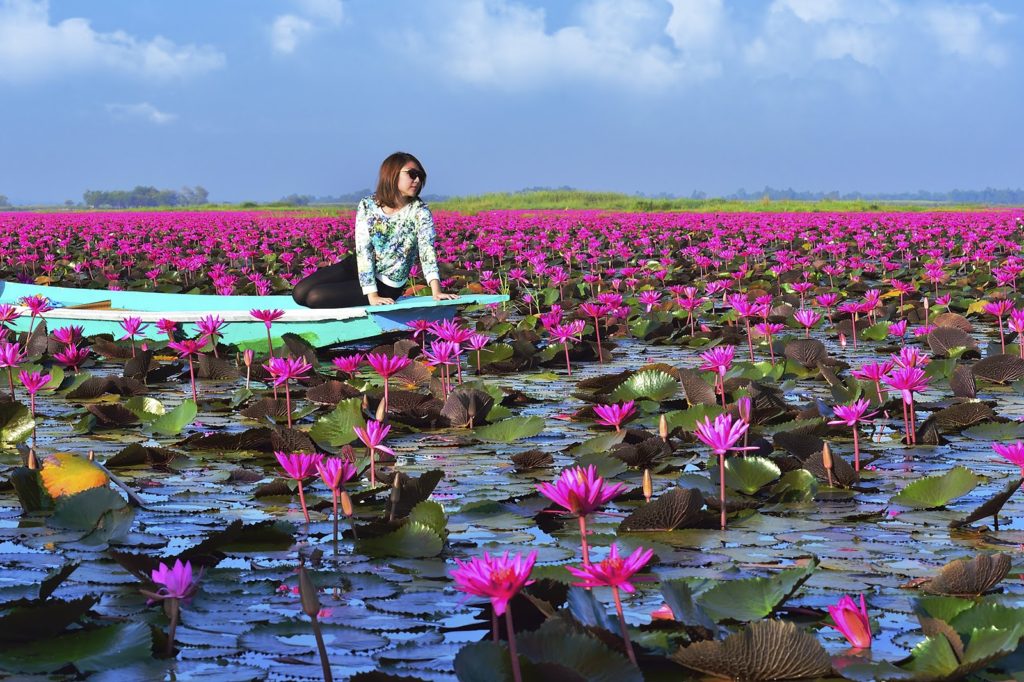
In Udon Thani, a Sea of Red Lotuses
If you are in Udon Thani, make it a priority to visit the beautiful Red Lotus Sea. Between October to January, the Talay Bua Daeng lake’s pink water lilies come into bloom, transforming its limpid waters into a pink spectacle as far as the eye can see. Hop aboard one of the pontoon boats at the water’s edge and enjoy the breathtaking view as the boat makes its way through the lotus blooms.
If you are interested in seeing more floating lotuses in Udon Thai, visit the Wat Santi Wanaram (or Wat Pa Dong Rai) temple north of Ban Chiang, which is constructed to look like a white lotus floating on the water.
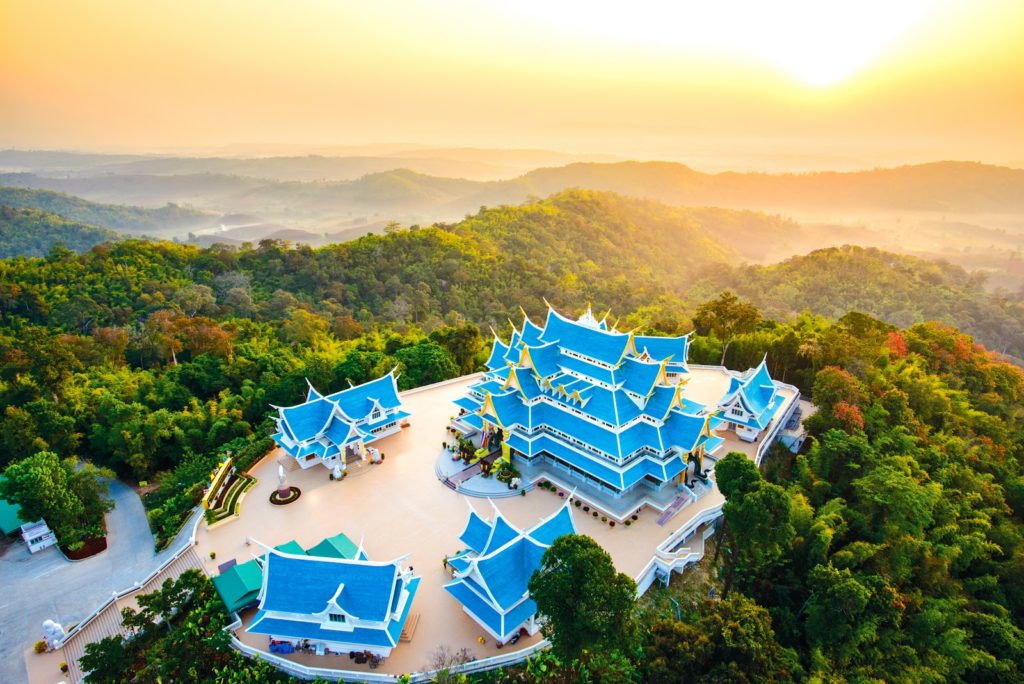
A Peaceful Escape in Udon Thani
Found inside the Na Yung-Nam Som National Forest Reserve in Udon Thani, Wat Pa Phu Kon is a peaceful oasis. The temple was designed as a secluded spot for monks to practice meditation and mental development. Inside the temple, you will find a 20-meter-long white marble Buddha laying on its side. There’s also a wall painting that shows the story of the ten reincarnations of Buddha.
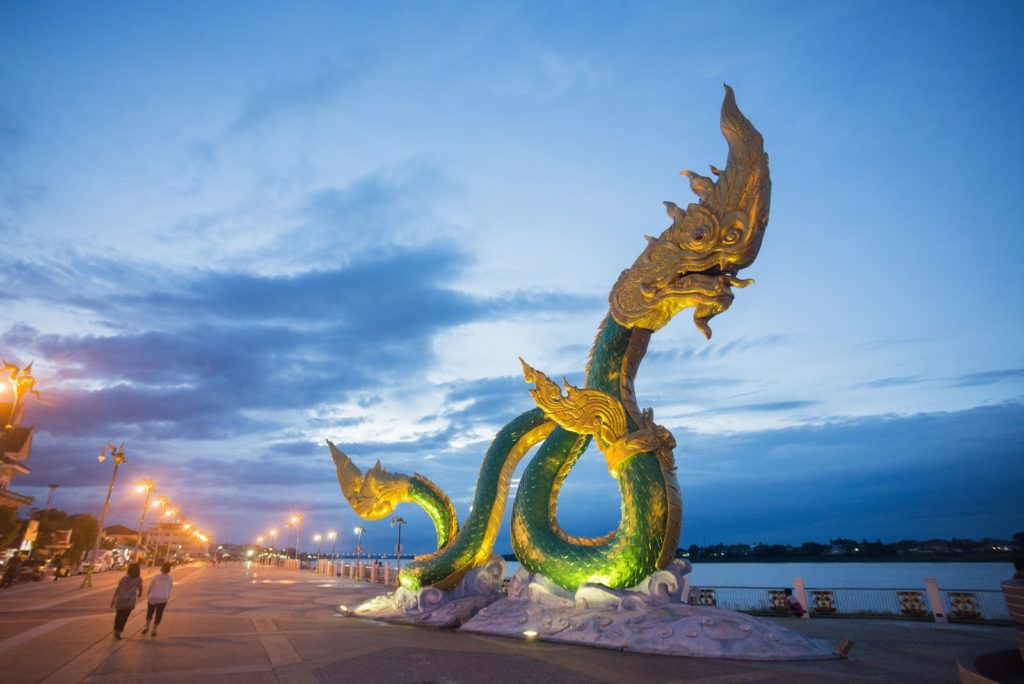
Nong Khai: a River Runs Through It
The Isaan of Nong Khai, a sixty-minute drive north from Udon Thani, shares their southern neighbors’ mystic feel, with the influence and legends of the Mekong River.
For instance, the river has been known to send mysterious ghost lights at the end of Buddhist Lent; the locals attribute this to the naga deities who live in the Mekong River.
The riverside promenade along the Mekong River in Nong Khai is a significant hub for business and leisure in the area. Bicycles are available for rent along the riverside, or at local guesthouses—for no more than 60 Baht, you can ride down the river’s edge and cover some of Nong Khai’s main tourist stops:
- Phrathat La Nong is the name for the broken remains of a 15th-century stupa, long since fallen into the river, and whose ruined tip peeks out of the Mekong River’s surface. A replacement stupa that was built at the original site also shares its name.
- Tha Sadet Market is a local market that brings in processed food, dried foods, and consumer products from Indochina and China. One of their specialty dishes is Noam Nueng; a Vietnamese dish that consists of roast pork and raw vegetables on a flat noodle sheet.
- Thai Lao Friendship Bridge is the first and most prominent bridge that linked Nong Khai in Thailand directly with Vientiane, the capital of Laos. Tourists stop at this point to catch the sight of the 1.2km-long bridge spanning both sides of the Mekong.
From 4 pm, the Khaem Khong Market opens, which combines authentic local goods, traditional Isaan food, and live musical performances to make a perfect end to one’s night in Nong Khai.
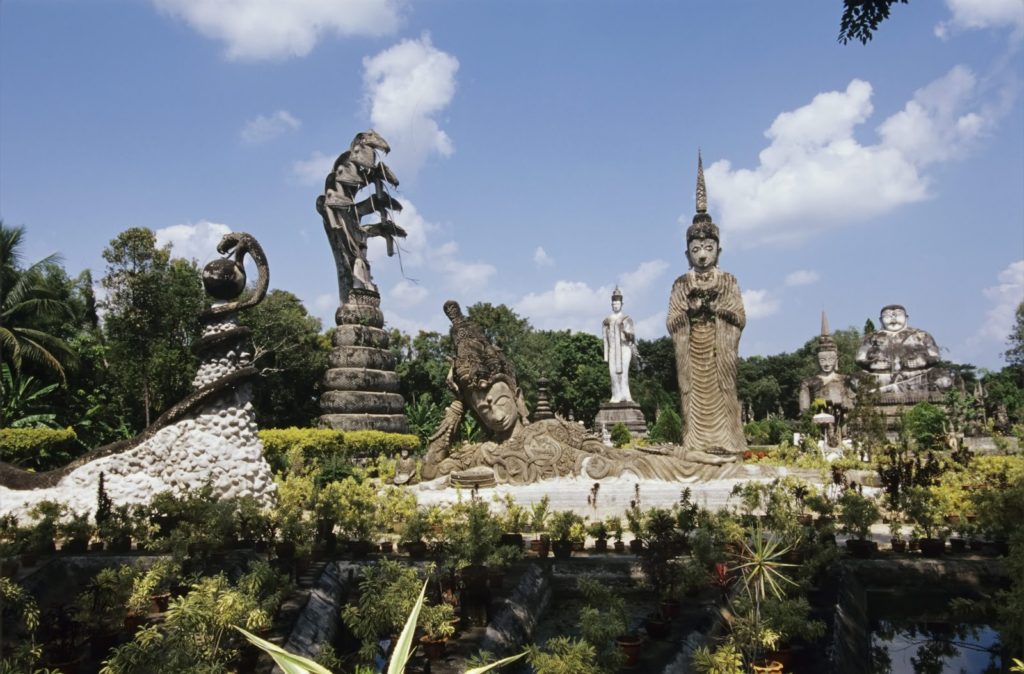
Nong Khai’s Surprising Cosmic Vision
If you’re into mystical sculptures, few places in Nong Khai can top Sala Kaew Ku, the life’s work of the late Lao mystic Luang Pu Boun Leua Sourirat. Driven by his eccentric vision combining Buddhist and Hindu cosmology, Luang Pu created a collection of statues that brought his ideas to life.
In Sala Kaew Ku, hundreds of sculptures depict Buddha, the Hindu gods, and a variety of allegorical tableaux. The Wheel of Life, located at the center of the park, represents Luang Pu’s interpretation of the Karmic circle of life. The circle of life depicts visitors entering through a gaping mouth and walk clockwise to recapitulate birth, life, and death.
Luang Pu passed away in 1996, but he never left the park. The main shrine building contains a tribute to his life, with mementos from when he was alive. His preserved remains can be seen in the center of the shrine, set under glass.
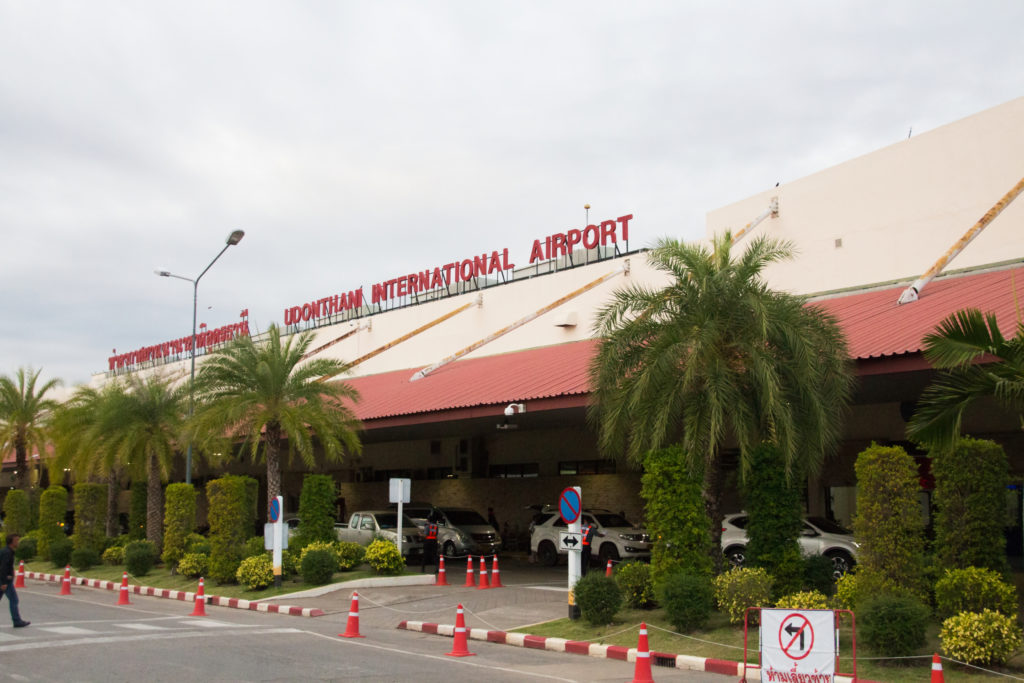
How to Get To Udon Thani & Nong Khai
Udon Thani International Airport serves regular flights from Bangkok-Don Mueang, Bangkok-Suvarnabhumi, Chiang Mai, and Phuket. Buses to Udon Thani depart from Mo Chit in Bangkok and take eight hours to get there. From Udon Thani, buses and mini buses regularly commute to Nong Khai, taking only an hour to get there.
The Udon Thani Train Station is part of Thailand’s Northeastern Line. Ten direct services connect Bangkok to Udon Thani, varying from 11 hours to 17 hours in duration. Sleeper berths are available, though not on all trains on this line. Family travelers are advised to book a first-class berth with private cabins.
Best Time to Visit
When planning your trip, try to schedule it to coincide with major Isaan festivals. The Rocket Festival (Bun Bang Fai) is held between April and June to welcome the rainy season. Awk Pansa is the end of the Buddhist rain retreat in October and is also when the ghost lights emerge from the Mekong River.
In mid-January, the Red Lotus Sea Festival occurs, and it celebrates the full blossoming of the lotuses on its namesake lake in Udon Thani.
Where to Stay in Udon Thani & Nong Khai
Travelers that go to Udon Thani usually stay at a hotel around Soi Sampantamit, since it’s close to the train and the old bus station. Other hotel options can be found around City Centre and Nong Prajak Park.
Nong Khai’s most in-demand accommodations can be found near the promenade along the Mekong.


